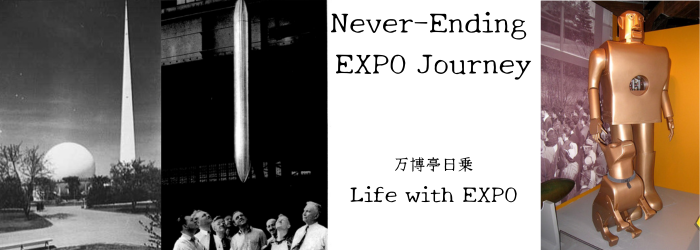This week is “Gaudí Week”
This week was Gaudí Week for me.
First, on Thursday evening, I headed for the Nihonbashi Public Hall ‘Nihonbashi Theater’ in Kakigara-cho, Nihonbashi, Chuo-ku, Tokyo, together with two assistants (actually they are family members) in the rain.
“The National Museum of Modern Art, Tokyo ‘ Gaudí and The Sagrada Familia’ Related Cultural Lecture”
In fact, the other day Assistant No. 2 found an announcement in a Chuo Ward public relations magazine about a cultural lecture related to the “Gaudí and The Sagrada Familia” Exhibition at the National Museum of Modern Art, Tokyo.
The date and time is Thursday, June 15th at 6:50 pm
The capacity will be 400 people by lottery.
Mr. Torii Tokutoshi, Professor Emeritus of Kanagawa University, was the lecturer, and the subject was “Gaudí and the Sagrada Familia – Why and how was this cathedral born?”
Moreover, it says, “We will give one invitation ticket to this exhibition to each person who attends the lecture.”
Since the application must arrive by May 25th, I immediately bought 3 return postcards at a convenience store and applied for 3 people, including one for Assistant No. 0.
It was my first time going to an event held by the ward, and I didn’t know if I would win or not, but in early June, all three of us seemed to have won, and we got “winning postcards”.
When we arrived, the reception was on the 4th floor of the building, and the hall also has seats on the 2nd floor. I came here for the first time, but it is a very fine hall.
As expected, there are many seniors in the customer base. Few young people. However, the intellectual awareness of the Japanese is so high that so many people gather for Gaudí ‘s lecture on a weekday night! I was impressed again.
What made me want to go to Gaudí ‘s lecture?
Of course, it is related to the World Expo.
Gaudí and the World Expositions – previous research
In my previous book, I wrote in detail about the relationship between the World Expos and Gaudí, but in short, the points are as follows. This is the result of the investigation so far.
Antoni Gaudí (1852-1926), an architect born in Catalunya, Spain, designed a showcase for a leather glove store in Barcelona, Spain called “Comellas” for the third Paris Universal Exposition in 1878.
This was recognized by Eusebi Güell who became a powerful patron of Gaudí .
The Expo created the meeting between Gaudí and Güell.
Gaudí also designed the pavilion for the Transatlàntic Company, a company run by Marquis Comillas, Güell’s father-in-law, at the 1888 Barcelona World Exposition.
This work was to refurbish the pavilion exhibited at the Cadiz Ocean Expo the previous year, and Gaudí remodeled it to look like the Alhambra Palace, and it is said that he gained a reputation.
Also, at the same Expo, Gaudí is said to have designed a memorial fountain in the venue.
There may be new discoveries related to the Expo at this lecture and exhibition.
That is the reason why I decided to go to this lecture (as usual).
Lecture by Tokutoshi Torii, Professor Emeritus of Kanagawa University
Mr. Tokutoshi Torii’s lecture was of a high level, like a lecture at a university, and it was very interesting as he made full use of various data and images. Of course, photography was prohibited in the venue, and it was too dark to take notes, so I can’t give you detailed and accurate information here, but there were a few things that I think are interesting to you readers.
For example,
・Gaudí was the second architect of the Sagrada Familia. At that time, he had no track record as an architect. Gaudí was 31 years old when he became the architect of Sagrada Familia (in 1883).
・The institution of the Sagrada Familia occupied no place in Catholicism. It was not a cathedral, a church, a chapel, or a monastery, but construction began as a “center” for the private organization ” the Asociación de devotos de San Joseph”.
・The industrial revolution created many poor people. For the salvation of those people, they decided to ask Joseph for salvation. Joseph is the husband of Maria and the adoptive father of Christ. The Holy Family (Sagrada Familia) is the family of Maria, Joseph and Christ.
・Construction started with donations from believers, but not much money was collected, and the foundation was in the red almost all the time.
・The second large-scale donation (anonymous donation) consisted of two checks addressed to Gaudí personally, and Gaudí decided to use this as a fund to proceed with his work using the interest. Also, since this donation was addressed to Gaudí personally, Gaudí became like “the owner” of this project.
・Gaudí died in Barcelona in 1926 at the age of 73 after being hit by a tram.
・With the tourism boom that began in the 1980s, an extraordinary amount of money (from entrance fee income) began to accumulate, and this unfinished cathedral is expected to be completed in 2026. Partly because of its financial background, the Vatican officially recognized the church as a “Small Basilica “.
For reference, the “Small Basilica” is described on the website of Oura Catholic Church in Nagasaki Prefecture as follows.
*
On April 26th, 2016, Oura Cathedral was given the title of “Small Basilica” for the first time in Japan.
A “Small Basilica” is “a church of particular historical, artistic, liturgical or pastoral importance, and which is the center of a vibrant community of faith, endorsed by the Pope” throughout the world. There are more than 1,700 in Japan, but only Oura Catholic Church is given that title in Japan.
*
It was a fulfilling lecture lasting an hour and a half, and it was very interesting to hear behind-the-scenes stories. The audience listened intently.
To the National Museum of Modern Art, Tokyo in Takebashi
On June 17th (Sat), I immediately headed to the National Museum of Modern Art, Tokyo in Takebashi with the invitation ticket I received.
It was my first visit there after the “Secrets of National Important Cultural Properties” Exhibition.
Organized by: The National Museum of Modern Art, Tokyo, NHK, NHK Promotions Inc., The Tokyo Shimbun
Co-Produced by: Fundació Junta Constructora del Temple Expiatori de la Sagrada Família
Supported by: Embassy of Spain in Japan
Sponsored by. Sompo Holdings, Inc., Dai Nippon Printing (DNP), YKK AP
Cooperated with: Iberdrola Renewables Japan
Academic Supervisor: Tokutoshi Torii (Professor Emeritus, Kanagawa University)
Tour: Shiga Venue: Sagawa Art Museum September 30th (Sat) to December 3rd (Sun), 2023
Aichi Venue: Nagoya City Art Museum December 19, 2023 (Tuesday) to March 10, 2024 (Sunday)
The exhibition had only just started, but it was a Saturday afternoon and many people were visiting.
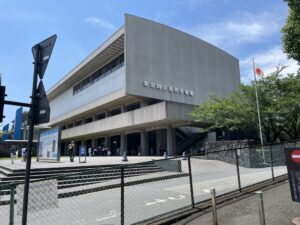
東京国立近代美術館
National Museum of Modern Art, Tokyo
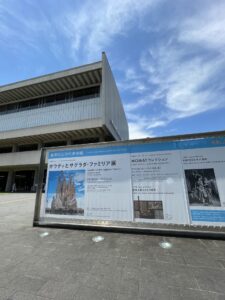
東京国立近代美術館
National Museum of Modern Art, Tokyo
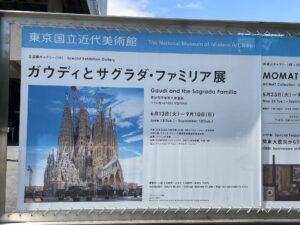
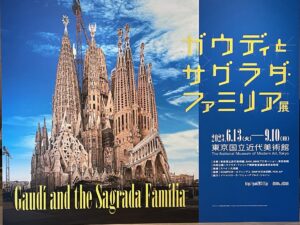
「ガウディとサグラダ・ファミリア展」サイン
Gaudí and the Sagrada Família
#ガウディ展
Actually, I have visited Barcelona and Sagrada Familia several times. The first time was in the late 1980’s.
After all, the Sagrada Familia, which I saw for the first time, had a strange impression, and I remember being impressed at first glance, “This is amazing!”.
The Sagrada Familia was not yet perfectly ready to accept tourists, so I remember entering the side entrance of a construction site surrounded by a fence and climbing a spiral staircase to one of the towers.
And I was able to see Gaudí’s works in Barcelona, such as Park Güell (1900-14), Casa Batlló (1904-96), and Casa Milà (1906-10).
When I saw Park Güell, I remember having a strong impression that this architect was anything but ordinary.
“1. Gaudí and His Time” – “ Sketch of the design for a display case for the Comellas glove shop. intended for the Universal Exhibition in Paris “
The exhibition is divided into four sections.
At the first section, “1. Gaudí and His Time,” there was an exhibition related to the World Expo as expected.
It is called Sketch of the design for a display case for the Comellas glove shop. intended for the Universal Exhibition in Paris ” (Municipal Museum of Reus, 1878).
This sketch is very small, but it is said that Gaudí himself drew it on the back of his business card.
It’s small, but when I used the monocular, it was certainly the one exhibited at the 1878 Paris Universal Exposition.
Nearby, there was also an exhibition titled “The Age of Gaudí and the World Expositions,” in which various illustrations from the latter half of the 19th century were introduced in video.
“2. The Source of Gaudí ‘s Originality” – “Antoni Gaudí’s season ticket of exhibitor’s pass for the Universal Exhibition in Barcelona”
In the section “2. Sources of Gaudí ‘s Originality”, there was an exhibition related to the Transpacific Company (La Trasatlantica) Pavilion at the 1888 Barcelona Universal Exhibition.
This is “Antoni Gaudí’s season ticket of exhibitor’s pass for the Universal Exhibition in Barcelona” (1888 Reus Municipal Museum).
It contains one of Gaudi’s (who is said to hate being photographed) precious 5 photographs without a hat.
I think it’s a very important document from the perspective of expo history.
When you actually look at it, it measures 7.2cm in height and 11.2cm in width (unfolded), which is actually smaller than you might think.
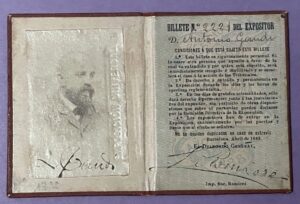
ラファエル・アレニャス・ミレート撮影
バルセロナ万国博覧会会場通行証 1888年
Photographer: Rafael Arenas Miret
Antoni Gaudí’s season ticket of exhibitor’s pass for the Universal Exhibition in Barcelona 1888
#ガウディ展
There was also an exhibition of Fragment of the “Compania Trasatiantica” plaque for the 1888 Barcelona Universal Exposition. I was surprised that such a precious thing is still kept and taken care of. It is said to be kept in the Sagrada Familia.
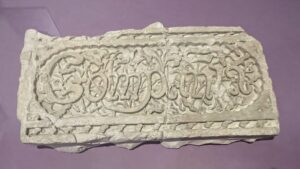
アントニ・ガウディ
1888年バルセロナ万国博覧会における大西洋横断者(ラ・トラサトランティカ)パビリオン、外装パネル
Antoni Gaudí
Fragment of the “Compania Trasatiantica” plaque for the 1888 Barcelona Universal Exposition
#ガウディ展
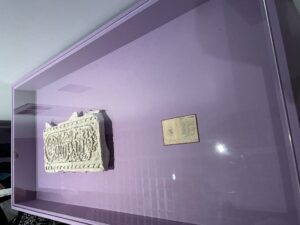
通行証(11.2 cm×7.2cm)と外装パネル(24×43.3×5.3cm) 比較すると通行証の小ささがわかる
Exhibitor’s pass and Fragment
#ガウディ展
Also, in the catalog of this exhibition, there are photographs such as “Gaudí: Barcelona Universal Exhibition 1888, Remodeling of Transatlantic Pavilion” and “Front Corridor of Transatlantic Pavilion”, and I was very impressed.
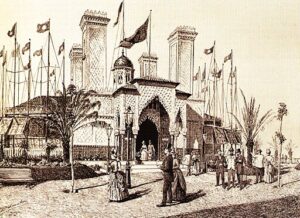
Trasatlántica Pavilion, 1888 Barcelona Expo
by Antoni Gaudí
Owen Jones, “The Grammar of Ornament”
After that, there was also an exhibition of Owen Jones’s “Grammar of Ornament” (Day and Son, London, 1856, Tokyo Polytechnic University Nakano Library).
Owen Jones (1809-1874) was an architect in charge of the colors of the Crystal Palace, the site of the 1851 London Great Exhibition, the world’s first international exposition, and he painted the Crystal Palace with blue, white, and yellow (The Crystal Palace itself was designed by Joseph Paxton).
The color decoration of the Alhambra is included in Owen Jones’ collection of designs that compiled decorations from all over the world, and it can be regarded as one of the precedents of Gaudí’s crushed tile technique seen in Park Güell and other places.
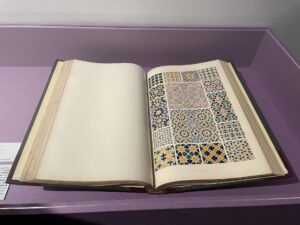
オーウェン・ジョーンズ「装飾の文法」
Owen Jones “The grammar of ornament”
#ガウディ展
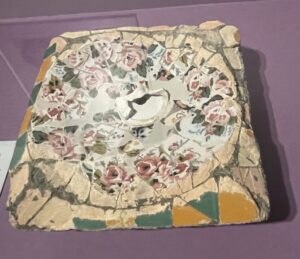
アントニ・ガウディ
グエル公園、破砕タイルと被覆ピース
Antoni Gaudí
Trencadis (Park Güell: ceramic mosaic piece)
#ガウディ展
The Cave Boom
It is said that the latter half of the 19th century was actually a cave boom.
Various caves such as limestone caves have been discovered in various parts of the world and have become a hot topic.
Considering world expositions, at the 1867 Paris Universal Exposition, an exhibition called the Cave Aquarium was already gaining popularity.
For this exposition, a huge elliptical exhibition hall “Palace du Champ de Mars”, about 1.5 times the size of the “Crystal Palace” of the 1851 London Great Exhibition, was constructed. The Krupp’s 50-ton cannon, Morse’s telegraph equipment, and the Suez Canal project were on display.
The venue consisted of seven concentric corridors. If you walked along the circumference of this corridor, you were able to see exhibits by product category and theme. And if you walked through the aisles that radiate from the center of the circle, you were able to see exhibits by country.
The center of the circle was a garden, and seven corridor-like exhibition spaces were created around it.
At this Expo, the previous method of exhibiting everything in one huge building ended, and various pavilions were built in the gardens around the main venue, the Champ de Mars.
And the “Cave Aquarium” was created by digging a horizontal hole in a corner called Jardin (Natural Garden), and it was divided into two parts, “Freshwater Aquarium” and “Seawater Aquarium”.
For the “Seawater Aquarium”, it is said that 600 cubic meters of seawater was transported from Normandy every day.
This time, the illustration of the “cave aquarium”, which was planned again for the 1878 Paris Universal Exposition, is on display. It is called “The Aquarium in Universal Exhibition in Paris, 1878, taken from The Graphic” (1878, private collection).
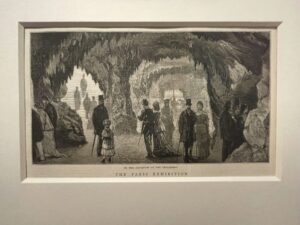
1878年パリ万国博覧会における水族館風景、The Graphic紙掲載
The Aquarium in Universal Exhibition in Paris, 1878, taken from The Graphic
#ガウディ展
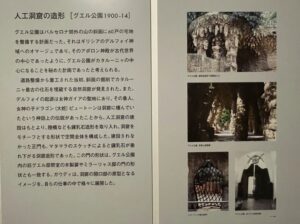
人口洞窟の造形(グエル公園)パネル
Molding of an Artificial Cave (Park Güell) panel
#ガウディ展
If you’ve been to Park Güell, you’ll know why this painting of a cave aquarium is on display. Gaudí has a unique design inspired by the shape of this cave.
“3. The Story of the Sagrada Familia”
“3. The Story of the Sagrada Familia” is a very fulfilling exhibition related to the Basilica of Sagrada Familia including many models and sculptures. The video corner including the video taken by a drone was also excellent, and the music playing in the video was also very good.
For many of you, this is probably the main point of this exhibition, but in this blog, I would like to leave that to the other bloggers and move on to the next section.
“4. The Legacy of Gaudí”
In “4. The Legacy of Gaudí”, videos and other works by architects who are believed to have been influenced by Gaudí are introduced.
In a video, there were also the works of Mr. Arata Isozaki (1931 – 2022) whom I introduced previously.
They are “Shanghai Himalayan Art Center” (2003-10) and “Qatar National Convention Center“. It is certainly a group of works in which the influence of Gaudí can be seen.
I first visited Barcelona in the 1980s, and saw around Gaudí’s works such as Sagrada Familia and Park Güell.
However, Gaudí established his career at a World Expo, worked on projects for the World Expo, and even influenced the Japanese architects who taught me a lot.
For me personally, the exhibition made me feel strongly about the continuity of human culture from the 19th century to the 21st century.
